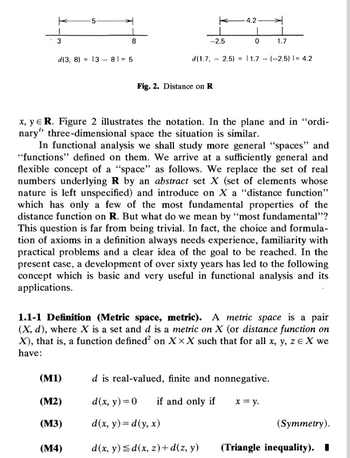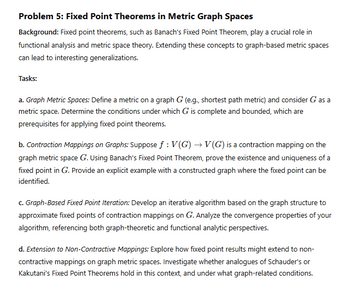
Algebra & Trigonometry with Analytic Geometry
13th Edition
ISBN: 9781133382119
Author: Swokowski
Publisher: Cengage
expand_more
expand_more
format_list_bulleted
Question
thumb_up100%
Make sure to answer by hand, make all graphs and give steps how you constructed these, DO NOT SOLVE USING AI
USE : https://drive.google.com/file/d/1a2B3cDeFgHiJkLmNoPqRsTuVwXyZz0/view?usp=sharing
For the reference, and the book kreyszig can be used,

Transcribed Image Text:3
K 5
8
K -4.2
-2.5
0
1.7
d(1.7, 2.5) 11.7 (-2.5) |= 4.2
-
=
-
d(3, 8) 13 81-5
Fig. 2. Distance on R
x, y = R. Figure 2 illustrates the notation. In the plane and in “ordi-
nary" three-dimensional space the situation is similar.
In functional analysis we shall study more general "spaces" and
"functions" defined on them. We arrive at a sufficiently general and
flexible concept of a "space" as follows. We replace the set of real
numbers underlying R by an abstract set X (set of elements whose
nature is left unspecified) and introduce on X a "distance function"
which has only a few of the most fundamental properties of the
distance function on R. But what do we mean by "most fundamental"?
This question is far from being trivial. In fact, the choice and formula-
tion of axioms in a definition always needs experience, familiarity with
practical problems and a clear idea of the goal to be reached. In the
present case, a development of over sixty years has led to the following
concept which is basic and very useful in functional analysis and its
applications.
1.1-1 Definition (Metric space, metric). A metric space is a pair
(X, d), where X is a set and d is a metric on X (or distance function on
X), that is, a function defined² on XXX such that for all x, y, z= X we
have:
(M1)
d is real-valued, finite and nonnegative.
(M2)
d(x, y)=0 if and only if
x = y.
(M3)
d(x, y) = d(y, x)
(Symmetry).
(M4)
d(x, y)d(x, z)+d(z, y)
(Triangle inequality). ■

Transcribed Image Text:Problem 5: Fixed Point Theorems in Metric Graph Spaces
Background: Fixed point theorems, such as Banach's Fixed Point Theorem, play a crucial role in
functional analysis and metric space theory. Extending these concepts to graph-based metric spaces
can lead to interesting generalizations.
Tasks:
a. Graph Metric Spaces: Define a metric on a graph G (e.g., shortest path metric) and consider G as a
metric space. Determine the conditions under which G is complete and bounded, which are
prerequisites for applying fixed point theorems.
b. Contraction Mappings on Graphs: Suppose ƒ : V(G) → V(G) is a contraction mapping on the
graph metric space G. Using Banach's Fixed Point Theorem, prove the existence and uniqueness of a
fixed point in G. Provide an explicit example with a constructed graph where the fixed point can be
identified.
c. Graph-Based Fixed Point Iteration: Develop an iterative algorithm based on the graph structure to
approximate fixed points of contraction mappings on G. Analyze the convergence properties of your
algorithm, referencing both graph-theoretic and functional analytic perspectives.
d. Extension to Non-Contractive Mappings: Explore how fixed point results might extend to non-
contractive mappings on graph metric spaces. Investigate whether analogues of Schauder's or
Kakutani's Fixed Point Theorems hold in this context, and under what graph-related conditions.
Expert Solution
This question has been solved!
Explore an expertly crafted, step-by-step solution for a thorough understanding of key concepts.
Step by stepSolved in 2 steps with 6 images

Knowledge Booster
Similar questions
- Below are four coordinate axes for 3-space, labeled I, II, III, and IV. Which sets of axes adhere to the Right-Hand Rule? エ. I. Only I Only II Only II Only IV OI, II, and IIl; not IV O1, II, and IV; not III Both I and IV; not II or III Both III and IV; not I or II All of them None of themarrow_forwardPlease anwer question 3(2.4) This is a math problem.arrow_forwardIs each statement true for circle A? Drag “true or false” below each statementarrow_forward
- In part a, can you please help me describe the range and the kernel of T in geometric terms like if it's a line, plane,... ?arrow_forward4. Give a geometric description of each family of planes.arrow_forwardMany smartphones are now able to use information sent out by GPS satellites (of which there are about nine overhead at any one time) in a similar way. Since the satellites are moving around in space, and therefore can’t be located on a two-dimensional map of the Earth, we now need to consider three-dimensional geometry. How many satellites are needed to be sure of the location of a smartphone? Explain your findingsarrow_forward
- The minimum vertical dimension (B) for the junction box shown in the Figure is _______arrow_forwardPart A: What are the coordinates of point A if you move it to the second quadrant tocreate isosceles triangle CAT?arrow_forwardSection L.2 Chapter 1 16. A manufacturer must describe a dimensioned part according to its x & y coordinates for a CNC (computer numerically controlled) od I G machine to produce it. These coordinates are る 5 measured relative to a datum. The x- coordinate is the horizontal distance from the datum, right is positive and left is negative The y-coordinate is the vertical distance from the datum, up is positive and down is negative. Fill in the chart that locates the holes and points that define the part. I G DATUM 4 2 P4 X - Coordinate Y - Coordinate P1 P3 13 7 PIO P5 P7 H I Pe P8 P10 H1 H2 H4 H5 H7 38arrow_forward
arrow_back_ios
arrow_forward_ios
Recommended textbooks for you
- Algebra & Trigonometry with Analytic GeometryAlgebraISBN:9781133382119Author:SwokowskiPublisher:Cengage

Algebra & Trigonometry with Analytic Geometry
Algebra
ISBN:9781133382119
Author:Swokowski
Publisher:Cengage